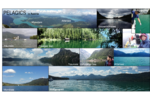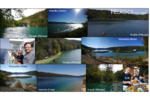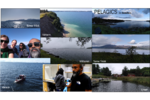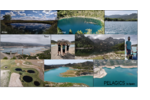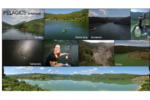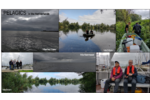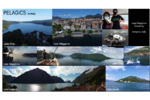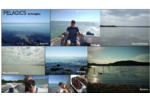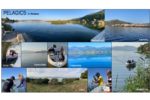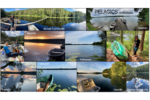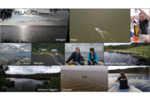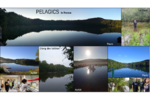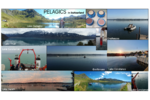Pan-European Lake Sampling - Microbial Eco-genomics (PELAGICS)
Principal Investigators: Rohit Ghai & Michaela Salcher
Financial support: Czech Science Foundation; Project No.: 20-12496X
Duration: 2020 - 2024
 - - -
- - -
77 Lakes
15 Countries
35 Collaboration Partners
24 Scientific Institutions
Spring/Summer
2020-2022
475 Metagenomes
33,542 Screened wells
4,723 Axenic cultures
273 Genomes
- - -
Published project results
Protists
Telonemia distribution and diversity in freshwater habitats by Roudaina Boukheloua et al. (2024)
Bacterial genetics
Genomic microdiversity of closely related taxa within the family Methylophilaceae revealed remarkably similar dynamics involving mobile genetic elements and recombination between freshwater and marine family members. Paul Layoun et al. (2024) ISMEJ
Postglacial adaptations enabled colonization and quasiclonal dispersal of ammonia-oxidizing archaea “Candidatus Nitrosopumilus limneticus,” in modern European large lakes by David Kamanda Ngugi et al. (2023) SciAdv
Maria-Cecilia Chiriac et al. (2022) in Environmenal Microbiology phylogenomically analysed a collection of >7700 metagenome-assembled genomes, classified habitat preferences on different taxonomic levels, and compared the metabolic traits of pelagic freshwater, marine, and freshwater sediment microbes to find the adaptive genetic traits in pelagic freshwater microbes.
Interactions
Uncovering the genomic basis of symbiotic interactions and niche adaptations in freshwater picocyanobacteria by Hongjae Park et al. (2024) Microbiome
Pelagial ecology
Auto- and mixotrophic protists dominated by cryptophytes were associated with spring algal bloom-specialized bacteria in the epilimnion. In contrast, the meta- and hypolimnion showcased a development of a protist community dominated by putative parasitic Perkinsozoa, detritus or particle-associated ciliates, cercozoans, telonemids and excavate protists (Kinetoplastida), co-occurring with bacteria associated with lake snow. Indranil Mukherjee et al. (2024) Environmental Microbiome
Even planktonic microorganisms enjoy four seasons in temperate waters as explained by Hongjae Park et al. (2023) Microbiome
The microbial spring in a freshwater reservoir is very dynamic from phytoplankton, flagellates, bacteria or viruses. But to follow it, you need to sample more frequently as explained by Vinicius S. Kavagutti et al. (2022) Microbiome
Viruses
We isolated and characterized a cryptophyte virus contributing to the annual collapse of a natural cryptophyte spring bloom population. This viral isolate is also representative for a clade of abundant giant viruses (phylum Nucleocytoviricota) found in freshwaters all over the world. We gave it a tentative name Budvirus. Helena Vieira et al. (2024) ISMEJ
Isolation of phages infecting the abundant freshwater Actinobacteriota order ‘Ca. Nanopelagicales’ by Vincius Kavagutti et al. (2023) ISMEJ
Lakes
Amadorio (Spain), Arcas (Spain), Attersee (Austria), Aydat (France), Balaton (Hungary), Banyoles (Spain), Breiter Luzin (Germany), Cadagno (Switzerland), Cep (Czech Republic), Cerne (Czech Republic), Certovo (Czech Republic), Cinciș Lake (Romania), Constance (Switzerland/Germany/Austria), Erken (Sweden), Etang des Vallées (France), Fântânele (Romania), Ferto/Neusiedl (Hungary), Garda (Italy), Gossenköllesee (Austria), Greifensee (Switzerland), Grosse Fuchskuhle NE (Germany), Grosse Fuchskuhle SW (Germany), Hallstätter See (Austria), Jiricka (Czech Republic), Kastoria (Greece), Klicava (Czech Republic), Kozjak (Plitvice) (Croatia), Kuc (Poland), La Claye (France), La Cruz (Spain), Landstejn (Czech Republic), Lugano (Italy), Maggiore (Italy), Majcz (Poland), Mälaren (Sweden), Markermeer (Netherlands), Medard (Czech Republic), Milada (Czech Republic), Mondsee (Austria), Most (Czech Republic), Nohipalu Mustjärv (Estonia), Nohipalu Valgjärv (Estonia), Orta (Italy), Pamvotida (Greece), Pavin (France), Peipsi (Estonia), Piburgersee (Austria), Plesne (Czech Republic), Prošće (Plitvice) (Croatia), Rimov (Czech Republic), Roś (Poland), Sant Maurici (Spain), Sfânta Ana (Romania), Slapy (Czech Republic), Stechlin (Germany), Știucii (Romania), Szymon (Poland), Tałtowisko (Poland), Tarnița (Romania), Thun (Switzerland), Tiefwaren (Germany), Torne Träsk (Sweden), Tous (Spain), Traunsee (Austria), Trichonida (Greece), Vänern (Sweden), Vättern (Sweden), Vechten (Netherlands), Velence (Hungary), Visovačko (Krka) (Croatia), Volvi (Greece), Võrtsjärv (Estonia), Vransko (Cres) (Croatia), Vransko (Zadar) (Croatia), Wolfgangsee (Austria), Zlutice (Czech Republic), Zurich (Switzerland)
Countries
Austria, Croatia, Czech Republic, Estonia, France, Germany, Greece, Hungary, Italy, Netherlands, Poland, Romania, Spain, Sweden, Switzerland
The PELAGICS Consortiums
Collaboration partners
Albin Alfreider, Adrian-Stefan Andrei, Horia L. Banciu, Anna Bednarska, Stefan Bertilsson, Corinne Biderre-Petit, Pedro J. Cabello-Yeves, Cristiana Callieri, Antonio Camacho, Camilla Capelli, Hans-Peter Grossart, Martin W. Hahn, Daniel P.R. Herlemann, Ludwig Jardillier, Konstantinos Kormas, Silke Langenheder, Cécile Lepère, Fabio Lepori, Purificacion Lopez-Garcia, David Moreira, Gerard Muyzer, Sandi Orlic, Jakob Pernthaler, Antonio Picazo-Mozo, Thomas Posch, Francisco Rodriguez-Valera, Nico Salmaso, Mirosław Ślusarczyk, Ruben Sommaruga, Bettina Sonntag, Nicola Storelli, Danijela Šantić, Helen Tammert, Viktor Tóth, Thomas Zechmeister
Local team
Rohit Ghai, Michaela M. Salcher, Roudaina Boukheloua, Paul-Adrian Bulzu, Clafy Fernandes, Markus Haber, Helena Henriques Vieira, Maria-Cecilia Chiriac, Kateřina Kabeláčová, Vojtěch Kasalický, Vinicius Silva Kavagutti, Fran Kostanjšek, Vojtěch Lanta, Paul Layoun, Hon Lun Wong, Indranil Mukherjee, Hongjae Park, Pavel Rychtecký, Tanja Shabarova, Tiberiu Szőke-Nagy, Karel Šimek, Petr Znachor
Scientific institutions
















